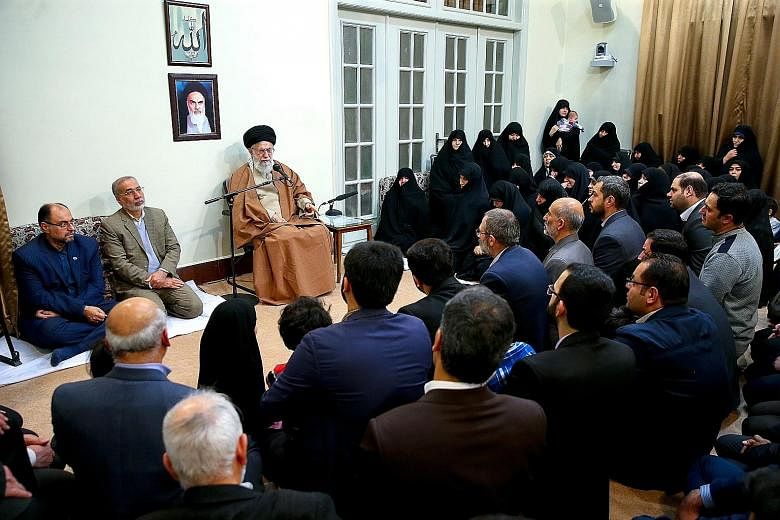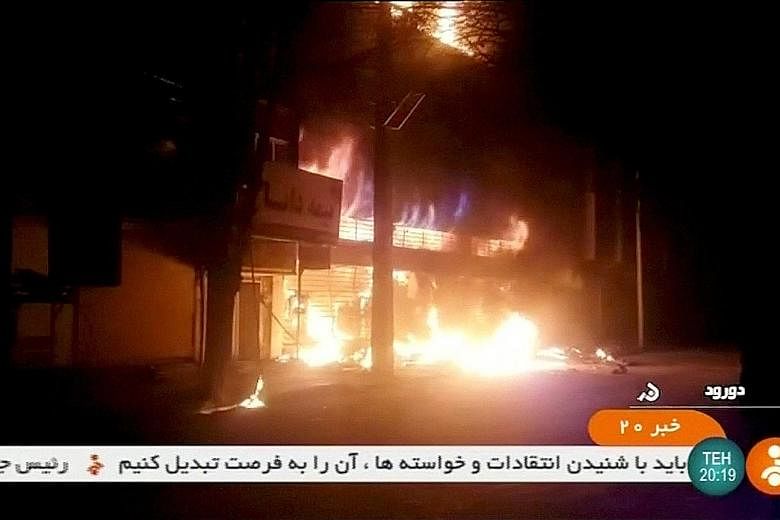ISTANBUL • Anti-government protests in Iran flared on more fronts yesterday amid clashes that left at least nine people dead, state media reported, as leaders in Teheran struggled to respond to the most serious internal crisis in nearly a decade.
Six days of demonstrations - which have left at least 20 people dead - showed no signs of easing as the anger from the streets found new targets.
What began as frustration over Iran's sluggish economy has broadened to include open defiance of Iran's Islamic leadership itself. There was no apparent evidence of cracks in Iran's ruling network of clerics and security networks, including the powerful Revolutionary Guard, whose influence extends deep into Iran's economy and policymaking.
But Iran's establishment was clearly caught off guard by the speed and ferocity of the protests - the largest outpouring of opposition to the state since the disputed 2009 presidential elections.
The protests have also underscored the range of tensions buffeting Iran, which has one of the region's most highly developed middle classes and among the most educated and tech-savvy populations.
Meanwhile, United States President Donald Trump praised Iranian protesters for acting against Teheran's "brutal and corrupt" regime after days of bloody unrest, while also lashing out at his predecessor Barack Obama.
"The people of Iran are finally acting against the brutal and corrupt Iranian regime," Mr Trump tweeted, a day after calling for regime change in the Islamic republic. "All of the money that president Obama so foolishly gave them went into terrorism and into their 'pockets'. The people have little food, big inflation and no human rights. The US is watching!"
Many young Iranians are frustrated by limits on reformers, including President Hassan Rouhani, to push for greater social freedoms and political openness in a country where the ruling clerics still hold all the cards.
Working-class Iranians and others, meanwhile, are increasingly unhappy with a stagnant economy despite the lifting of international sanctions under the nuclear accord with world powers.
In a replay of the rhetoric from 2009, Iran's Supreme Leader, Ayatollah Ali Khamenei, posted comments yesterday to assert that the current protests were encouraged by the country's "enemies" - often used as shorthand for the United States, its allies and anti-government Iranian exiles.
"In recent days, enemies of Iran used different tools, including cash, weapons, politics and intelligence apparatus, to create troubles for the Islamic republic," said the statement from Ayatollah Khamenei on his official website.
He made no comment on how security forces should confront the demonstrations, saying only that he will address the nation "when the time is right".
But other top officials have called for harsher crackdowns.
Ayatollah Khamenei's claim of outside links to the protests suggested that he viewed the events as more than a domestic upheaval and could support much tougher measures.
Also worrisome for Iran's leaders is the spread of the protests into provincial areas, traditionally conservative strongholds not often drawn into the political activism led by groups in Teheran and other cities.
The latest bloodshed occurred in towns around the central city of Isfahan. State television said six of the latest casualties occurred during an attack on a police station in Qahdarijan. The clashes were allegedly sparked by protesters who tried to steal guns from the station.
The demonstrators appeared to be leaderless and their demands diffuse, ranging from better living conditions to more political freedoms and even an end to the Islamic republic.
Their chants and attacks on government buildings broke taboos in a system that brooks little dissent.
The prospect of a harsher response from security forces raised fears of further violence in a country buffeted by conflict elsewhere in the region. WASHINGTON POST,
AGENCE FRANCE-PRESSE


